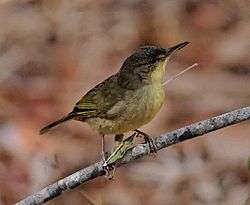Madagascan warbler
The Madagascan warblers are a newly validated family of songbirds. They were formally named Bernieridae in 2010. The family currently consists of eleven species (in eight genera) of small forest birds. These birds are all endemic to Madagascar.
| Madagascan warblers | |
|---|---|
 | |
| The long-billed bernieria (Bernieria madagascariensis) was formerly placed in the Pycnonotidae | |
| Scientific classification | |
| Kingdom: | Animalia |
| Phylum: | Chordata |
| Class: | Aves |
| Order: | Passeriformes |
| Superfamily: | Sylvioidea |
| Family: | Bernieridae Cibois, David, Gregory & Pasquet, 2010[1] |
| Genera | |
|
see text | |
| Wikispecies has information related to Bernieriidae |
In 1934, the monophyly of this group was proposed by Finn Salomonsen but the traditional assignments of these birds were maintained, mistaken by their convergent evolution and the lack of dedicated research. The families to which the Malagasy warblers were formerly assigned—Pycnonotidae (bulbuls) and even more so Timaliidae (Old World babblers) and the Old World warbler—were used as "wastebin taxa", uniting unrelated lineages that were somewhat similar ecologically and morphologically.
It was not until the analysis of mtDNA cytochrome b and 16S rRNA[2][3] as well as nDNA RAG-1 and RAG-2 exon sequence data,[4] that the long-proposed grouping was accepted.[5]
Taxonomy and systematics
The family contains 11 species divided into 8 genera.[5]
- Oxylabes – White-throated oxylabes
- Bernieria – Long-billed bernieria
- Cryptosylvicola – Cryptic warbler
- Hartertula – Wedge-tailed jery
- Thamnornis – Thamnornis
- Xanthomixis – (4 species)
- Crossleyia – Madagascan yellowbrow
- Randia – Rand's warbler
Several of these species are very poorly known and were described by science only very recently. Appert's tetraka was only described in 1972 and the cryptic warbler in 1996. The Appert's tetraka, along with the dusky tetraka are threatened by habitat loss, and are listed as vulnerable.
Most Malagasy warblers live in the humid rainforests in the east of Madagascar, though a few species are found in the drier south west of the island. They feed on insects and will form mixed-species feeding flocks of up to six species while foraging.
References
- Cibois, Alice; David, Normand; Gregory, Steven M. S.; Pasquet, Eric (2010). "Bernieridae (Aves: Passeriformes): a family-group name for the Malagasy sylvioid radiation" (PDF). Zootaxa. 2554: 65–68.
- Cibois, Alice; Pasquet, Eric; Schulenberg, Thomas S. (1999). "Molecular systematics of the Malagasy babblers (Passeriformes: Timaliidae) and warblers (Passeriformes: Sylviidae), based on cytochrome b and 16S rRNA sequences". Molecular Phylogenetics and Evolution. 13 (3): 581–595. doi:10.1006/mpev.1999.0684.
- Cibois, Alice; Slikas, Beth; Shulenberg, Thomas S.; Pasquet, Eric (2001). "An endemic radiation of Malagasy songbirds is revealed by mitochondrial DNA sequence data". Evolution. 55 (6): 1198–1206. doi:10.1554/0014-3820(2001)055[1198:AEROMS]2.0.CO;2. PDF fulltext
- Beresford, P.; Barker, F.K.; Ryan, P.G.; Crowe, T.M. (2005). "African endemics span the tree of songbirds (Passeri): molecular systematics of several evolutionary 'enigmas'". Proceedings of the Royal Society B. 272 (1565): 849–858. doi:10.1098/rspb.2004.2997. PMC 1599865. PMID 15888418.
- Gill, Frank; Donsker, David, eds. (2018). "Grassbirds, Donacobius, Malagasy warblers, cisticolas, allies". World Bird List Version 8.1. International Ornithologists' Union. Retrieved 27 January 2018.
Further reading
- Del Hoyo, J.; Elliot, A. & Christie D. (editors). (2006). Handbook of the Birds of the World. Volume 11: Old World Flycatchers to Old World Warblers. Lynx Edicions. ISBN 84-96553-06-X.
- Roberson, Don (2006): The break-up of the Old World warblers: A discussion of the 'new' tree. Version of 2006-06-26. Retrieved on 2007-05-12.
- Salomonsen, F. (1934): Revision of the Madagascar Timaliine birds. Ann. Mag. Nat. Hist. (10th series) 14: 60–79.